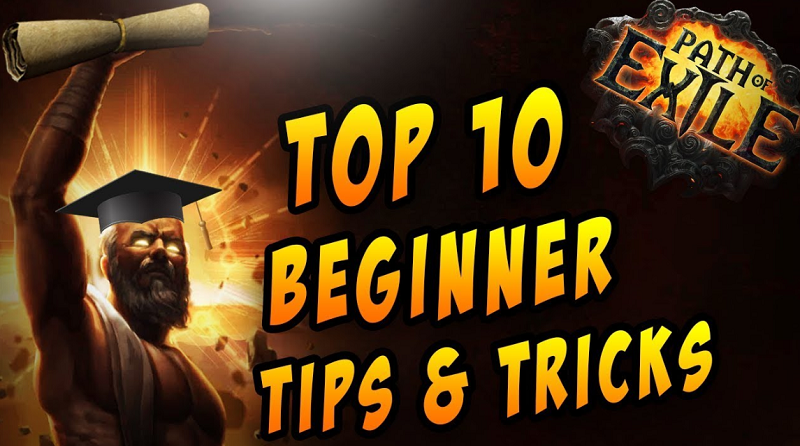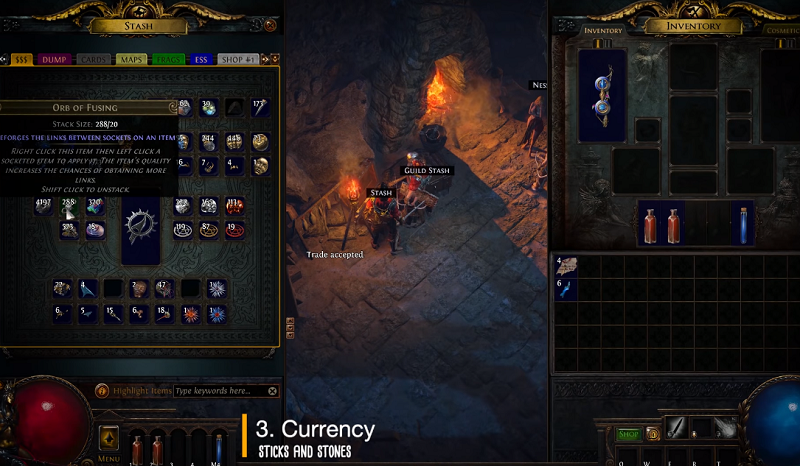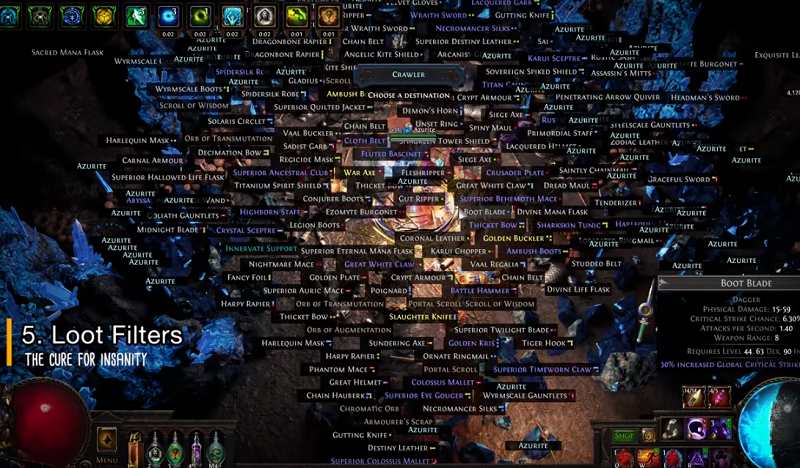The Path of Exile 3.8 expansion will be released with the new contents, items, features and more details, then how to start POE 3.8 Blight? This Path of Exile 3.8 Beginner guide aims to bring new POE players top 10 tips and tricks that will help you get familiar with some of the most important aspects of the Blight League.

More Read: Path Of Exile 3.8 Blight Atlas Strategy - Best Maps To Shape/Elder In POE Blight League
Path Of Exile 3.8 Best Beginner Guide - Top 10 POE Blight Starter Tips & Tricks
Path of Exile 3.8 is an amazing game with so many different facets which can make your head start to spin. Players new to the game, in particular, are sometimes frustrated by how complex and interlocking many of the game’s systems are. Failing to understand some of the fundamentals can weaken your ability to make progress in the game, or or make you lose interest in the game. In order to fix this issue for you, here goldkk.com brings 10 best tips for POE 3.8 Blight League Starters. Covering topics of Flasks, Builds Guide, Currency system, Classes and Ascendancy, Skill Gems, Leagues and more. If you're a beginner, you'll surely find answers to many questions you might related to these. You will likely find some useful advice even if you're more experienced or returning players.
1. Path Of Exile Blight Leagues
You can think of these as sort of realms or sub-servers, each with its own set of rules and limitations as well as entirely separate markets. You can have different characters created on different leagues at the same time, but they cannot interact with each other and do not share their stashes.
Standard is a permanent type of league where your progress, items, as well as the economy itself are never reset. Then there are the temporary leagues which last around 3 months and always have the latest content and features as well as a fresh economy each time. Everyone starts from scratch, on an equal footing so you won't be at a disadvantage if you're a newcomer. Once a temporary league ends all the characters along with their gear and everything else in your stashes are moved to Standard league. When a temporary league ends, whatever new features were introduced in it, are migrated to Standard as well.
2. Path Of Exile 3.8 Classes
After you made your decision on the league, you need to select which class you'll be playing. Unlike most RPGs out there, in Path of Exile 3.8 Blight, this doesn't determine what skills or type of gear you can use. There are three major things which are dictated by the class: Ascendancy, the starting position on the passive tree and character appearance. Ascendancies are a set of sub-classes that each class can choose from after completing the Labyrinth. Skills are granted to players through gems, all of which become available to all classes later in the game. While focusing is generally more efficient, many of the all-time best POE 3.8 Blight builds have been created by breaking these molds.
Related Read: POE 3.8 Blight Ascendancy Changes - Path Of Exile 3.8 Saboteur, Assassin, Raider, Necromancer Ascendancy Rework & Update
3. Path Of Exile 3.8 Currency
After you've decided on the league and class, you make your way through the beach and finally reach the first town with an inventory full of POE items to sell. You find a vendor, dump all that trash and you get a whole bunch of pieces of paper. You've just discovered Path of Exile's currency system. Unlike most other RPGs out there, the game doesn't use gold or silver but rather a whole bunch of orbs, scrolls and stones each with a very specific purpose. Apart from trading with other players, each piece of currency in Path of Exile 3.8 is actually a crafting material which can be used to manipulate items in a certain way.

For example, an Orb of Transmutation will upgrade a Normal, white, rarity item into a Magic, blue, rarity item. An Orb of Augmentation can add an additional property to a Magic Item and a Regal Orb can upgrade such an item into a Rare one. Apart from being used directly on items, they're also required for purchasing various stuff from vendors as well the crafting bench in your hideout. Of all these various currencies, Chaos Orbs are the closest you can get to a gold standard. The vast majority of items traded between players are priced in chaos orbs so keep an eye out for these golden nuggets. The end-game, rare and expensive items, are generally priced in Exalted Orbs, a much rarer currency which is anywhere between 100-200 times more valuable than a Chaos Orb. So if you do get lucky and find one of these, try not to waste it and research its value in the league you're playing.
4. POE Blight Vendor Recipes
However there's also a smarter way of going about selling items to NPCs and that is Vendor Recipes Simply put, by selling certain groups of items you will get much more than you would if the items were sold invidually. In addition, items with particular affixes, links or sockets can be sold for a decent amount of specific currencies. While there are over a hundred vendor recipes and even a few more that are currently unknown.
You need a helmet, body armour, belt, gloves, boots, amulet, two rings and for the weapon slots you can go with one of the following: two 1-handed weapons, a 1-handed weapon and a shield, a 2-handed weapon or two shields. If all these items are unidentified you will instead get 2x Chaos Orbs. If their item level is 75+ then you obtain Regal Orbs instead of chaos and these are somewhat more valuable. This is a great vendor recipe especially when you're just starting out or at the beginning of a new league. It will help you get those first bunch of Chaos Orbs to buy some decent gear. As you progress through the game you might find yourself short of Wisdom Scrolls and constantly picking these up becomes time-consuming. It is far more efficient to pick up Orbs of Transmutation or Blacksmith's Whetstones and then vendoring these.
5. POE 3.8 Blight Gems and Skills
Killing monsters is the obvious way but what's less evident is how you get the skills to do that. Path of Exile 3.8 Blight doesn't use a classic system where your class dictates what abilities you will have available and leveling up doesn't automatically provide new spells or attacks. Instead you will use skill gems which will grant new abilities when placed in a socket of the appropriate color on a piece of gear that you have equipped. Gems can be broadly split in two major categories: Active Gems and Support Gems. The former will generally grant an ability such as an attack skill or spell while the latter can modify the properties or behavior of active skills which are linked to it. Links are these yellow lines connecting two sockets and the more of them you have in a chain, the more support gems you can fit and thus further boost or modify a particular active skill.
6. Loot Filters For POE 3.8
Finding the right items for these recipes might seem quite difficult at first but luckily you can use a Loot Filter to help you with that. These are small configuration files that tell the game how to visually highlight and display certain dropped items, as well as hide useless junk. The further you progress into the game the more loot is dropped and unfortunately 99% of it is junk. Without a loot filter it becomes literally impossible to manually sort through all of it and it would be a huge waste of time anyway. Fortunately you don't need to create a loot filter yourself as there are plenty of them out there that have been finely tuned by very experienced players.

7. POE Blight League Orbs
Orbs of Regret are a special type of currency used to undo various things. Its most basic utility is to obtain a passive refund point by simply right-clicking on the orb. These can be then used to refund points in the tree by unspeccing unwanted passives. While you also get a few of these refund points as rewards from various quests, they might prove insufficient, especially if you want to switch to an entirely different build or to change your Ascendancy. Orbs of Regret can also be used to change the reward you picked from the “Deal with the Bandits” quest in Act 2. For this you will need to vendor 20 Orbs of Regret along with a specific amulet, depending on which reward you're looking for. Still, using Orbs of Regret might not be necessary if you're closely following a good build guide.
8. POE 3.8 Build Guides
For the overwhelming majority of new players in POE 3.8 Blight, a good build guide will make the difference between enjoying the game and giving up on it in frustration. A build is a lot more than just picking up certain passives in the tree - active skills, support gems, secondary gems setups, gear, flasks, jewels, ascendancy and so on, all have to actually work together to deliver a functional thing. Apart from helping you perform much better, a good Path of Exile 3.8 build guide is also a great teaching tool from which you can learn a lot about the game in general. So where can you get a good guide? Check out the Best Path Of Exile 3.8 Builds - Top 3 POE Blight League Starter Builds.
9. POE 3.8 Blight Divination Cards
If you've already started following one or more build guides then you've likely noticed that some of them require, or are greatly improved, by certain unique items. At the start of a new league, or when playing solo-self-found, getting all these items might be quite difficult. Luckily there is a way to more reliably farm certain items through Divination Cards. These are a special type of item which can be collected and exchanged for a specific reward. Multiple copies of the same card make up a set and once you have a full set you can take it to Navali to obtain the reward indicated on the cards.
Most divination cards drop in a few specific areas or maps so you can target-farm them quite easily. Of course you can also buy few cards from other players as well and complete the set. Not only can you mix farming with buying and thus end up cheaper but cards are much more abundant on the market than the final items themselves. Apart from items there are divination cards for pretty much everything in the game: currency, fragments, essences, maps, 5 or 6-link items and so on. There are currently over 250 card sets in the game and more are added with each league so I strongly suggest to check out the page of Path of Exile Wiki Divination Card for the entire list.
10. POE 3.8 Blight Flasks
You might find a lot of valuable ones that you can easily farm at your level and get a decent amount of currency. Of all the existing gear pieces in the game, flasks are probably the ones that get ignored most by new players. While in most RPGs out there potions are generally limited to healing or replenishing mana, Path of Exile Blight puts a lot more emphasis on these. So much so that there's even an entire Ascendancy class revolving around flasks.
Apart from the usual life and mana, there are a whole bunch of utility flasks as well as a wide range of unique ones that provide various bonuses. Each flask has a maximum number of charges and you spend a certain amount of these every time you use that flask. You gain charges when killing monsters, with magic, rare and unique mobs providing more of these. On top of their main utility such as healing or buffs to evasion or armour, they can host a lot of very useful affixes that will help you deal with some of the toughest debuffs you will encounter, especially in end-game. They can also greatly improve your clearing speed or damage output, all for the cost of a few Alteration Orbs.
Hope the 10 Path Of Exile Blight starter tips can help you play better in the new League Blight. We’ll keep updating more POE 3.8 beginner guides, stay tuned!